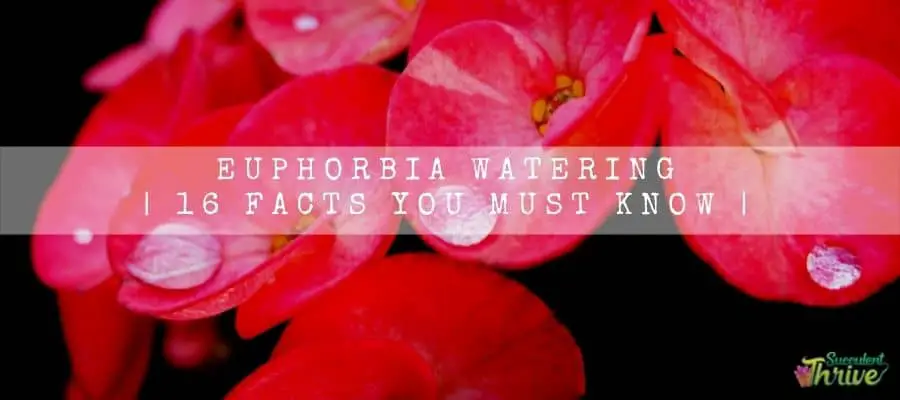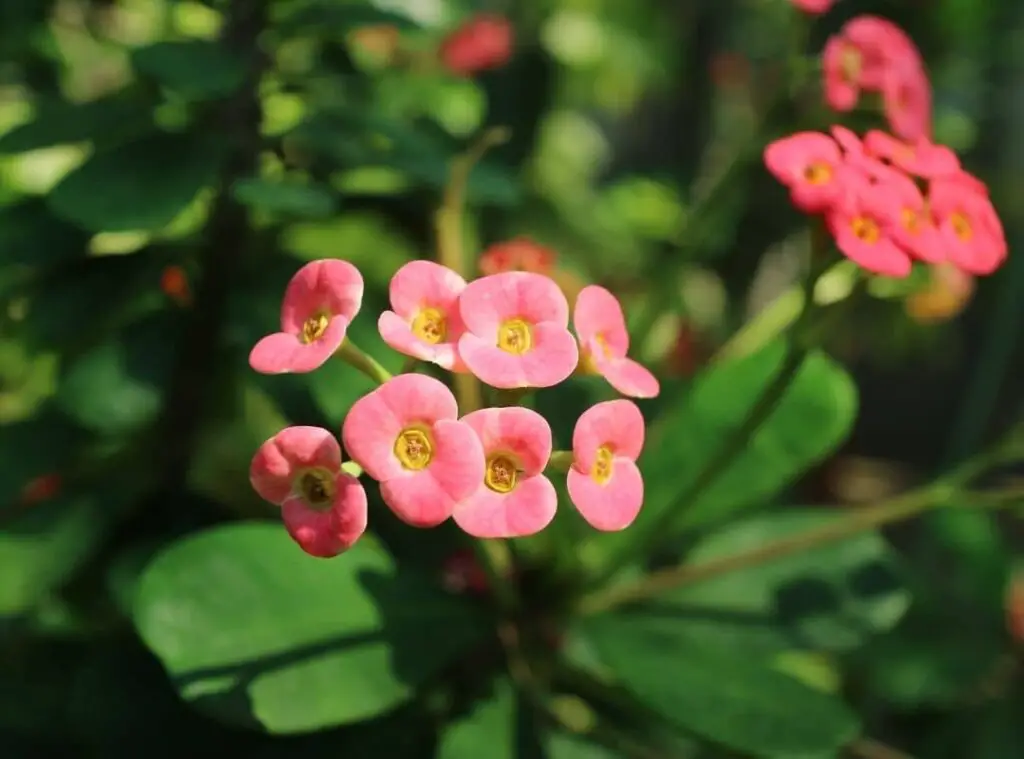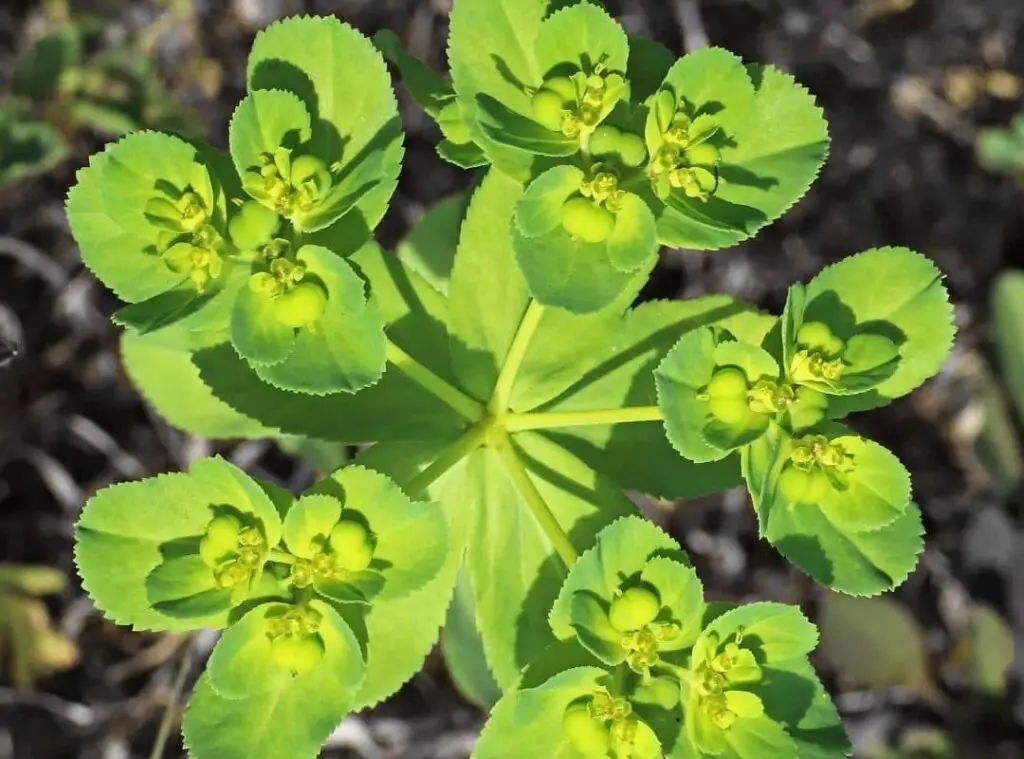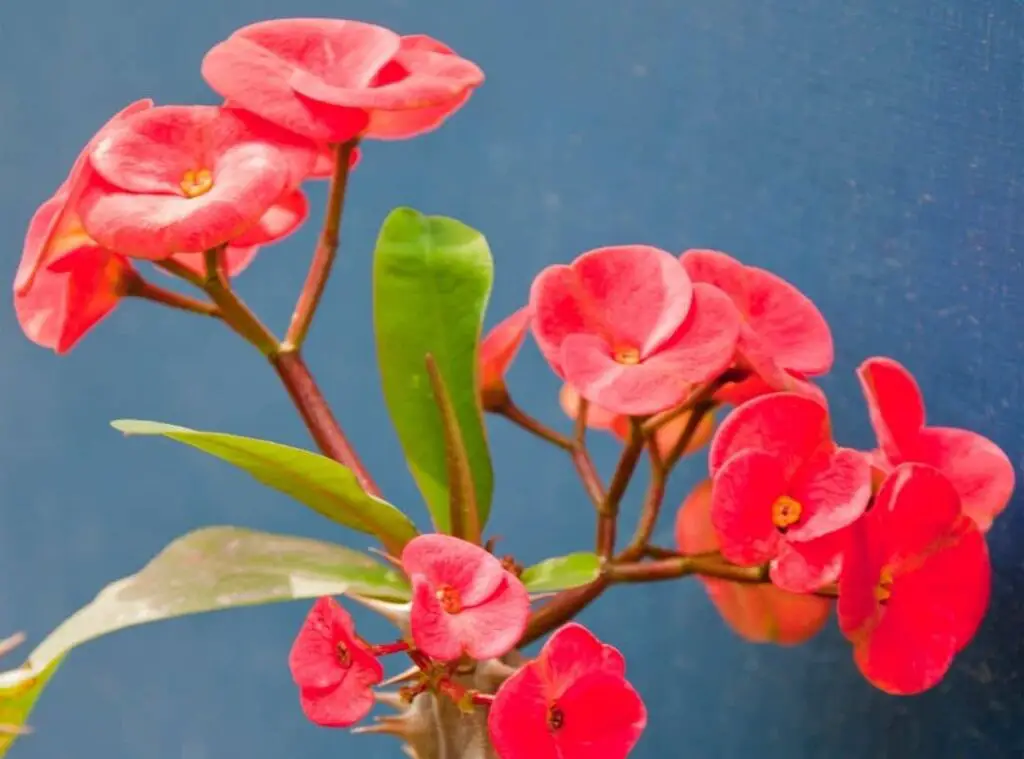Euphorbia watering techniques are easy to learn and very important for their survival. In this article I am going to discuss some easy but essential facts about euphorbia watering.
Keep reading if you want to learn more on this topic.

How to tell when euphorbia needs water
In the general context, succulents need water when their soil is dry in condition. If you find your plants are showing any underwatered signs such as wilting, you need to consider watering them.
Moreover, if you feel like their soil is dry, you could start watering them. Having said that, you need to check the soil status a few times to assure that soil is dry.
Although Euphorbia plants are adapted to grow in drought conditions they still need water to survive.
They can go waterless and survive, but not for too long. Ideally a layer of 2.5 cm should be dry and that is an indication to let you know that they need water.
On the other hand, you could start watering them if you spot your Euphorbia plants have started wilting, particularly during winter.
However, when you hear the term ‘Watering ‘you should keep in mind that you should not over-water them at any given point of time.
If you need to assure whether their soil is dry, you could simply stick your finger in the soil for about one inch and check whether their soil is dry or damp.
If it is too soggy and damp, you need to wait for some time and then water. As aforesaid, you need to water them during winter less often.
When you water them, ensure that you do it in the morning so that the moisture could evaporate during the daytime when the temperature goes up.
Keep in mind that if you have grown these plants in pots or in containers, you need to water them more often twice thrice per week.
Euphorbia watering frequency
When it comes to watering frequency, it could be once or twice during summer. On the other hand, it could also be two or three times per week too.
You need to ideally assure that the soil is entirely dry between watering sessions. Additionally, you should check whether the excess water is moving through the draining holes too.
Over watering is the biggest concern of these plants as it is the main culprit for many diseases.
On the other hand, you need to suspend watering them during winter given that they get winter rainfall. If required, you could water the Euphorbia plants just once a week.
No matter what you need to water them only if their soil is dry only.
How long it can go without water
Euphorbia plants could go waterless for a maximum of two months.

Watering euphorbia without drainage
Succulents in general need their soil to wither as soon as possible simply because they do not prefer to be in waterlogged situations.
As such, if you have draining holes in the pot, that will make this process easier as the excess moisture could drain through.
If the pot does not have sufficient draining holes, that will cause root rot in the pot. Hence why it is crucial that you are growing them in pots which consist of draining holes.
Particularly if you are fresher in succulent gardening, you need to adhere to this concept. Once you become an expert in succulent gardening, you could go for all these fancy containers which do not have drainage holes.
You might want to grow them in pots which do not have draining holes as you will start to think, what if the water starts to come out from the pots.
However, in that case, you need to grow them closer to your window. Furthermore, if you wish to go ahead with a pot which does not have a draining hole, it is very crucial that you provide them with a soil mix which has excellent drainage.
That will have a great impact on the plant’s health and on vigorous growth as well.
Keep in mind that water has nowhere to go and hence, you need to provide them with adequate room for them to evaporate.
You could be tactful with this in arranging the soil along with some large particles. Substance like pumice would be ideal for this purpose.
You could arrange them in a glass container as that will give a nice look for the entire set up. No matter what, keep in mind that your soil mix has a good aeration.
When you water the plants which do not have drainage holes, it is mandatory that you measure the water level.
This has become a major problem, as gardeners cannot remember how much water they put in.
In this circumstance glass containers would be ideal as then you could have a track.
If you go ahead with some other material, there will be a high potential of occurring over watering situations.
As such if you measure the water you pour in, it will avoid any over watering situation. To do that you could use a measuring cup and measure the water you put in.
Further, you may use a squeeze bottle. You could easily find them in a garden tool set. Not only that but also, you could use pipettes also for this purpose.
Euphorbia watering amount
This is something challenging you have to do, as it would be somewhat tricky to do this even if you have some specialized tools for this.
If you have made the soil moist, you have done your job properly. However, you should double check whether there is any water retained in the bottom of the pots though.
In case, if you had unintentionally poured so much water, you could use either rag or paper towels to remove some. Further if you have a tiny pot, you could pour the excess moisture off of it.
If you have grown them in pots which do not have drainage holes, you need to watch out for any indication of watering faults.
Ideally you need to water them with half of your soil amount when watering them. Consider that you have one cup of soil, then you need to water them with half a cup of water.

Euphorbia water from top or bottom
You should water the euphorbia plants from the bottom which will consequently allow the plants to absorb water slowly.
To do that you could place the plants in a shallow dish or even in a tray filled with water for about 2-3 inches of water.
Euphorbia watering in winter
You need to minimize watering the Euphorbias during winter. Further you need to ensure that your plants are bone dry during winter particularly before you water them.
To do that ideally, you could let the plants stand in water saucers and let it absorb the maximum moisture it can.
Keep adding water and ensure that all water is absorbed by the plant and there is no left in the saucer.
Euphorbia watering in summer
Euphorbia plants’ actively growing phase usually falls in summer. Hence you need to enhance watering gradually from late spring to spring.
That will ensure that their soil is not bone dry instead dry in condition. This literally means, their soil is not wet and at the same time not crackly and chalky too.
Make sure you do not let them be bone dry during summer as then you will come across signs of under watering such as shriveling.
Indoor euphorbia watering
Euphorbia plants are native plants in Africa, as such they can thrive in intense heat as well as in partial sun shade too.
Hence if you grow them as house plants, you should place them near a bright sunny window.
First to start off When you are watering the indoor grown Euphorbias during spring and summer you need to ensure that their soil is slightly moist particularly during spring and summer.
Having said that, do not let them stand in waterlogged or soggy soil conditions. If you do so, it could be so attractive towards diseases such as root rot.
Keep in mind that if you water the indoor grown Euphorbias you need to grow them in pots which have draining holes.
That will ensure that the excess moisture is draining through those holes. Moreover , you need to grow them in a well draining soil mix as well.
A soil mix like succulent soil mix or a cactus soil mix would suit them the best. Keep in mind that you need to water them more compared to what you do for outdoor grown euphoria.
Outdoor euphorbia watering
Weather conditions and the outdoor euphoria go hand in hand, as you need to adjust watering depending on the weather conditions.
If you provide them excess water, it could even make fatal repercussions on the plants. if you are someone who receives constant rainfall, you could suspend watering them.
In addition, if you think it is way too much for the plants you may even bring them indoors to keep them in dry conditions.
Generally, you do not need to water the outdoor grown Euphorbia plants as often as you do with indoor grown Euphorbias.
You need to literally water them very rarely. However, check whether their soil is dry or hot and water them accordingly.
If you see any signs of under watering, you could enhance watering them. On the other hand, avoid over watering the outdoor Euphorbias also since it could make the plants more prone towards root rot.

Small euphorbia watering
You need to water the small Euphorbias only if their soil is bone dry. Literally you need to allow their soil to be dry between two watering sessions.
If you think their soil is soggy, refrain from watering them for some time. Literally you need to give a good soak of water and let them wither afterwards.
Should you water newly brought euphorbia
This is not necessary as you only have to water them if their soil is dry only. Avoid providing them excess water.
Should you water newly repotted euphorbia
You may water the newly reported euphoria after you report them. When they find water, they could start to form their new growth towards that direction.
Repotted plants could absorb little water and they could form new roots to replace the old ones. When you water them, do it thoroughly.
Consider that you water them a little on a daily basis. Then only the top layer of the water will penetrate.
Then it will make the roots will not grow firmly and vigorously simply because there is no water left for them as it will be only in the top layer.
In other words, shallow water contributes to weak root growths and they will not be useful for firm root formations.
Hence, water them deeply after you repot the euphoria. Having said that water will evaporate but there will be moisture retained in the soil from the vigorous root formation would be benefitted.
Consequently, it will help the plant to anchor and make the plant absorb more moisture and nutrients as well.
If you water them prior to repotting them, , it will create more damage for the roots and will make it more difficult to shake the roots.
Ideally your soil needs to be starving for water when you report them. Hence conduct repotting on their watering day and water them after you report them.
What you need to water a euphorbia
- Watering can
- Water measuring cup
- Water squeeze bottle
Do Euphorbias need more water than cactus?
Euphorbias need more water than cactus as euphorias require you to water them when their soil is dry.
On the other hand, cactus could go waterless for prolonged periods, and they can thrive well in such conditions.
Does Euphorbia like humidity?
Euphorbia plants prefer to grow in high humidity levels. Simultaneously they are fond of growing in high temperature levels as well.
However if you are growing the Euphorbias in winter, there should be low levels of humidity available around the plants.
Conclusion
Before wrapping this up, trust now you are very well aware of how to water these plants depending on their season, the ways of doing it and even on the tools you need to have to water them too.
Read Next 11 Interesting Pencil Cactus Watering Techniques Important Snake Plant Watering Techniques | 12 Things You Must Consider | Euphorbia Fertilizer | Do Euphorbia Really Need Fertilizer? |
